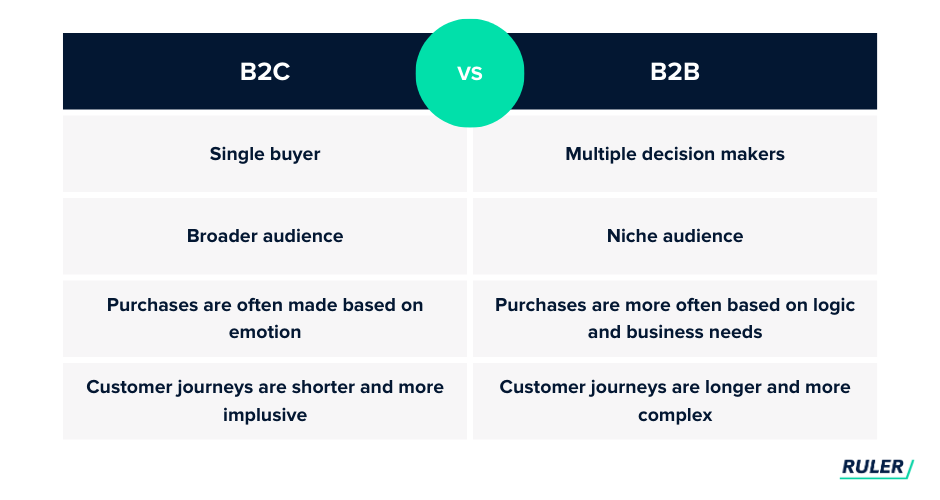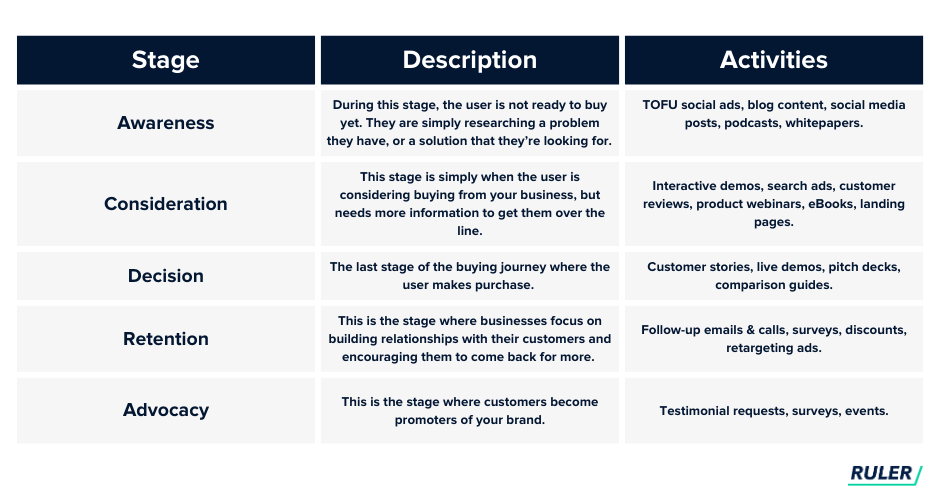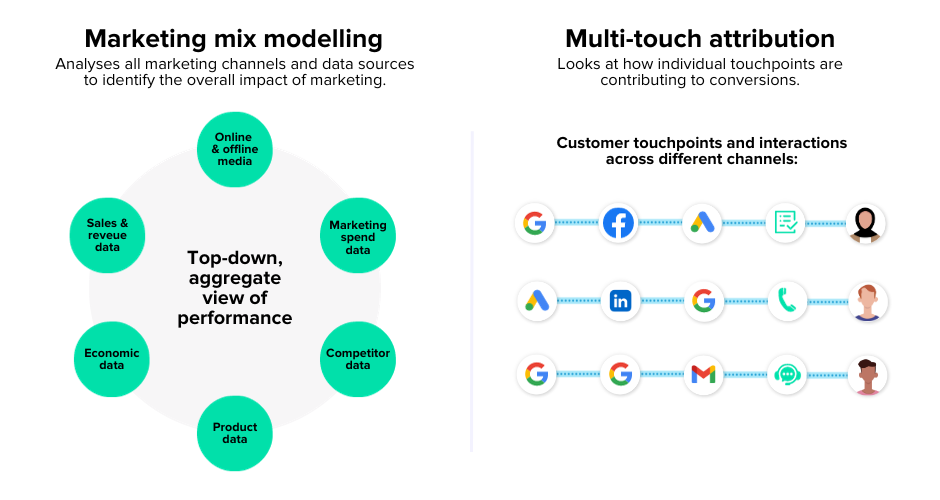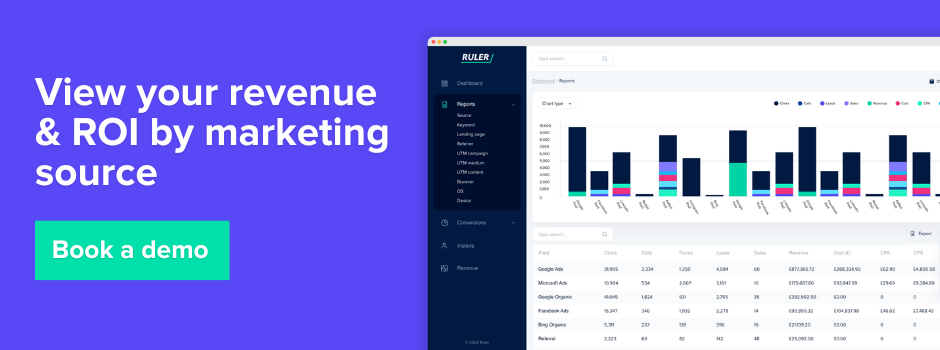Understanding your B2B customer journey could help you optimise your budget, drive more results and better understand your customers.
91% of marketers say that lead generation is their most important goal. And it’s no surprise. In B2B, you can’t often convert a sale right on-site.
Chances are, your users need to speak to an expert or share more information to make sure they’re getting the best product or service.
Leads aren’t as easy to track as on-site sales. As a consequence, B2B marketing leaders don’t know where to put their marketing spend.
And that can lead to erratic marketing strategies that are optimised just for driving new leads.
We’ll explore:
💡 TL;DR
– Generating leads is a great start, but it’s not enough to guarantee revenue. To maximise your chances of converting leads into customers, you need to focus on the entire customer journey, from awareness to purchase to post-purchase.
– B2C journeys are typically shorter and more impulsive, while B2B journeys are longer and more complex, involving multiple decision-makers and stakeholders.
– The best way to create and map a B2B customer journey depends on your specific business and needs, but a common approach is to divide it into the following stages: Awareness, consideration, decision, engagment & retention and advocacy.
– The simple way to track the B2B customer journey is to set up URL parameters and lead tracking for forms, etc. However, marketing attribution tools can link together data from different marketing sources with your CRM tool to provide a more complete and accurate view of the customer journey.
Although B2B marketers should track their lead volume, it’s not enough to prove marketing success.
And for good reason.
A lead doesn’t guarantee revenue. So if you’re generating hundreds of leads via Facebook for example, but none of them ever convert, well then you’re wasting time and budget on a channel that isn’t working for you.
Related: How to track the value of your leads
Of course, not every piece of marketing content is going to generate revenue, and nor should it. But you should at least be getting a channel by channel view of where revenue is coming from.
By changing the narrative from lead tracking to pipeline tracking, you can start to pull all the pieces of the puzzle together.
Related: What is pipeline generation and how to get started
With this view, you’ll see how many leads you generate.
But then you’ll see how many of those leads turned into a sale.
Understanding this will help you turn off what isn’t working and turn up what is.
A B2B journey is simply the steps a user takes from their first interaction with your business all the way through, and sometimes beyond, buying your product or service.
Related: B2B marketing metrics to measure and improve your results
A B2B customer journey differs from a regular customer journey for a number of reasons:

The first is an obvious one. With a B2C purchase, you’re mostly dealing with just one customer.
With B2B, you’re dealing with multiple decision-makers, and perhaps their teams too. It might be that the decision-maker doesn’t even use your product or service, so identifying the people who do is key to sales, retention and growth.
B2C marketing teams will still want to engage with their customers post-purchase, but the way they do, similarly to the way they buy, will be very different.
A B2B marketing team, depending on the product or service, may have a more bespoke method of engaging with customers. Or perhaps they have ongoing engagement with them through customer success.
This can drastically change what your B2B customer journey looks like.
Of course, this is up to interpretation and how you best want to tackle creating and mapping your customer journey.
We generally split out a B2B customer journey into the following stages:

These five stages are very commonly used to break down a customer journey.
But remember, this is just how we try to organise actions with no discernible trend. After all, every user will use your website differently and engage with your content differently too.
However, mapping out a rough idea of a potential user flow is key to creating quality content for each stage of their customer journey.
In this stage, the user has never heard of you before, so this stage is where they first get any awareness of you.
And so, in this stage, you’re likely doing a lot of brand awareness activity. That could be prospecting adverts on social, writing top-of-the-funnel blogs for a problem they have and more.
During this stage, the user is not ready to buy yet. They are simply researching a problem they have, or a solution that they’re looking for.
This is where issues start to come into play. One user might have a problem they’re trying to solve, in which you’re presenting yourself as a solution. Another might not even be aware they even have this problem.
It’s important to consider both of these when creating your content. Most marketers cater to the first scenario, but not the second. This is often referred to as creating demand.
Related: Demand generation vs demand capture
This stage is simply when the user is considering buying from your business, but needs more information to get them over the line. It’s likely they’re comparing lots of different suppliers.
So, you need to stand out.
How do you do that? Provide value.
Don’t endlessly sell. Give your users information and detail on how to get more from whatever problem they’re solving.
Become a brand they can trust.
Case studies are a great way to do this. As are walkthroughs which we’re starting to see more and more of on LinkedIn.
Get ahead of the curve!
The last stage of the buying journey is where the user purchases.
Sometimes, a user can jump straight to you in this stage as they’ve done all of their research elsewhere.
This is where forums and reviews are really important. If you’re being recommended as a top provider, then users will come to you with very little prompting.
They could also be tipped over by a good deal. This is where ads can get you over the line, as you can push your value (literally).
Now for some businesses, this won’t be relevant.
Users might buy and then you never need to see them again.
But for many businesses, particularly in B2B, improving your engagement and retention is a key business goal.
And for good reason.
It’s 7 times cheaper to retain a customer than go out and get a new one…
Here, you need to rely on a really good customer service or success team and really smart onboarding and email sequencing.
Understanding what keeps users coming back is vital for achieving consistent growth.
Last but certainly not least is advocacy. Remember when we mentioned reviews and forums? You need to get your customers to a point where they are going out on their own whim and feeding back about you.
This relies mostly on your product or services. But you can also ask for it. Create an incentive to fill in a feedback form on a site like G2 and see if that sparks any more reviews.
64% of marketers agree that word-of-mouth is the most effective form of marketing.
Tracking each of these stages isn’t easy. There could be hundreds of marketing touchpoints occurring in any one user’s customer journey, so how do you bring all of that together?
Plus, what about impressions? A user seeing an advert is just as important sometimes as them clicking on it.
A simple way to start tracking your B2B customer journey is to set up URL parameters and lead tracking for forms etc.
But this is still only going to give you a small part of the story.
The best way to go about tracking these complicated journeys is to integrate marketing mix modelling alongside marketing attribution.

Related: Complete guide to marketing attribution
While complex to begin with, both of these strategies are great ways of taking difficult data that’s locked app to app and making sense of it.
You’re left with clear reports on where users are coming from and what they’re engaging with.
And with this data in your arsenal, you can start to create clearer B2B customer journeys based on what content is being engaged with at each customer journey stage.
💡 Pro Tip
We’re experts in marketing mix modelling, but we know it’s not simple to get your head around. Book a demo with our team to learn exactly how Ruler integrates marketing mix modelling as part of your data stack.
While tracking a customer journey might sound impossible using typical tools like Google Analytics or your CRM, all you’re missing is a tool that can connect the data together.
Ruler Analytics is a marketing attribution tool that helps marketers use historical data and statistical modelling to predict how business performance changes depending on a change in strategy.
Book a demo to see exactly how it works and our experts can walk you through what data we can give you and how you can use it to untangle your customer journeys.
